Issue:
Club Members share their remembrances from the FCCJ’s 42 years at the Yurakucho Denki Building North Tower.
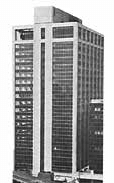
A SHOUT-OUT TO THE PM
SANDRA MORI IS ONE of a select few who have actually set foot in all four premises the Club has used since its foundation in November 1945. They are the old Tokyo Kaikan (1945-1954), the former American Club Building, Marunouchi (1954-1967) the Chiyoda Annex Building (1967-1976) and the Yurakucho Denki Building (1976-2018).
“My first visit was with my Dad in 1947 when I was 11. I remember summer night film shows on the roof of the old Tokyo Kaikan, organised by the Zenier brothers Gene and Julius (aka Julie). There was no air-conditioning then,” she says.
Mori’s most treasured memory of FCCJ life in the Yurakucho Denki Building was the visit by then Prime Minister Junichiro Koizumi on Sept. 14, 2001. “It had been some years since a Japanese premier had visited the Club. The Foreign Correspondents’ Club was the Jaws of Death, seemed to be the attitude in Nagatacho,” says Sandra.
When Koizumi strode purposefully into the packed Main Dining Room, Sandra like a true Edokko greeting a favorite actor at a Kabuki performance called out, “Yooo! Matemashita!” which translates as “We’ve been waiting for you.”
Koizumi stopped in his tracks and breaking into a smile turned towards Sandra in acknowledgement. “Ah! That’s Kabuki” he said. But before he could make more than eye contact, one of his minders gently but firmly steered the prime minister towards the podium. Sandra’s brief moment of mixing with the powers that be passed into oblivion, largely unnoticed by the media throng, leaving her, she admits, “All of a quiver” as the charismatic politician walked past.
Apart from that stellar experience Sandra a keen volunteer who has organized numerous FCCJ entertainments over many years remembers “so many fun things” during the four decades plus in Yurakucho. Modestly she plays down the leading part she took in establishing the “Saturday Night Live” music event in the Main Bar as one of the Club’s unique contributions to the Tokyo music scene.
“Glenn Davis [now retired in Texas] got this event started,” Mori says. “The intention was to make the Club more cheerful and I can honestly say that we’ve done that.”
Now Sandra is looking forward to similar good times at the Marunouchi Nijubashi Building, and planning the inaugural party for Nov. 22.
– Sandra Mori
Member since 1969
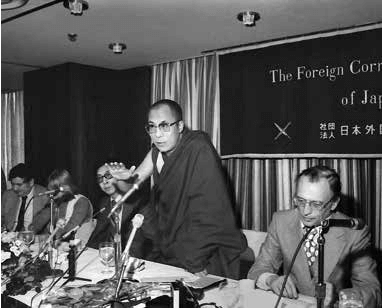
THE DALAI LAMA,
1980 (from this month’s FCCJ Photo Archives Exhibition)
A PHOTOGRAPHER’S LAMENT
THERE ARE SO MANY individual incidents that it’s hard to choose just one. How do you pick between a past president falling off his backless barstool in the old Stag Bar and breaking his arm or a widely told tale about a Filipina woman charging into the club with a kitchen knife in search of her husband and/or his alleged lover with whom she believed he was having an affair, among so many others.
One conversation I do remember was with Karl Bachmeyer, who accompanied General Douglas MacArthur when he made his return to the Philippines in 1945. Karl didn’t get any shots of the general striding through the surf because he was stuck with the complicated process of reloading his Leica camera. I knew how complicated it was, since I had some of those Leicas: the film had to be trimmed manually beforehand, and then very carefully inserted using both hands.
– Ichiro Urushibara
Member since 1964
“IT HAD BEEN SOME YEARS SINCE A JAPANESE PREMIER HAD VISITED THE CLUB.
THE FOREIGN CORRESPONDENTS’ CLUB WAS THE JAWS OF DEATH, SEEMED TO BE THE ATTITUDE IN NAGATACHO.”
RANDOM THEATRICAL THOUGHTS . . .
SAM JAMESON WAS MY mahjong student and became my sponsor when I joined in 1972. I once asked him why he ran for FCCJ president, and he replied “I didn’t like the other guy so I ran against him and got the seat.” I forgot who he defeated. . . .
. . . For my “Macbeth” production at the FCCJ, then GM Nakamura insisted that the audience at the FCCJ would never exceed 100. “Our members aren’t that intelligent,” he said. I offered to bet him that we’d do better than that. “It’s a deal,” said Nakamura, “and I’ll give you half of the ticket price of the audience over 100.” Well, it seems FCCJ members were more cerebral than he thought. The box office was 135, so I walked away with half of the price of the 35 tickets. (There’s still a sword scar on the main dining ceiling from one of Macbeth’s fights) . . . .
. . . After I attended “The Winds of God” in Shinjuku, the playwright Masayuki Imai begged me to bring his popular play to the FCCJ. “I want the foreign press to know the true faces of the kamikaze,” he told me. So we staged it to a full house audience at no cost to FCCJ. I think the story of the young pilots’ suffering and their training changed the image of the kamikaze among media members and associate members alike. . . .
. . . When I was doing the gaijin casting for the TV documentary, “Unrealized Japan Divisional Occupation Plan,” I chose the FCCJ for the premiere. After the screening was held, a Russian reporter angrily protested to the writer director why the Japanese family had to escape from the Russian occupied zone to the US. zone. After looking around at the roomful of foreign correspondents, the director dodged the question, saying, “Oh, they could have run away from the American zone just as well. That’s not my theme in the film.” That was too much for me. “Liar!” I whispered.
This is my 46th year and I still love my Club.
– Junichi Takahashi
Member since 1973
CLOSE ENCOUNTER OF THE AWKWARD KIND
I HAD AN ODD experience at the Club when Mr. Yukio Hatoyama, the former prime minister of Japan, visited the FCCJ for a press conference. I think it was in 2011. I finished lunch at the Main Bar counter and ready to return to work headed for the 20th floor entrance hall to wait for an elevator. When one arrived, Mr. Hatoyama stepped out of it. Seeing me standing alone, he walked toward me smiling, with his right arm stretched out.
Taken aback and not wanting to embarrass Mr. Hatoyama, I shook his hand and mumbled, “Welcome to the Club.” Then, in my eagerness to escape from the awkward situation, I rushed into another elevator whose doors were about to close, and vanished without a trace.
I have been wondering ever since what went through Mr. Hatoyama’s mind at that moment, and what he thought about his strange reception at the Club.
– Richard R.F Ginies
Member since 1978
“FOR MY MACBETH PRODUCTION AT THE FCCJ, THEN GM NAKAMURA INSISTED THAT THE AUDIENCE AT THE FCCJ WOULD NEVER EXCEED 100. “OUR MEMBERS AREN’T THAT INTELLIGENT,” HE SAID. . .”
HARD WORK AND LUBRICATED DEBATE
THE CLUB SEEMED MUCH more of a working journalists’ hangout in the early 1980s when I first joined. Those were the days when news reports were written on a typewriter then filed by telex and for those of us who didn’t belong to a news bureau, that meant trying to find a vacant space among the cubicles lining a corridor like room at the back of the Library (which was then on the 20th floor).
Work went on around the clock, especially for those writing for different time zones, and even after the Main Bar closed (which was very late at night), drinks could always be had, on a help yourself basis, in the intimate Shimbun Alley bar, with Marilyn’s famous nude photograph gracing the wall. (Whatever happened to that picture, I wonder?*)
No matter what time of night you arrived, there was guaranteed to be a well lubricated, hot debate going on between correspondents on the issues of the day, with the likes of the young Richard Pyle, Mike Tharp, Bradley Martin, Andrew Horvat, Bruce MacDonell and others at the heart of the fray. Those were heady times, with a vibrancy that one doesn’t feel today.
– Roslyn Hayman
Member since 1981
*It’s in storage at the Club (ed.).
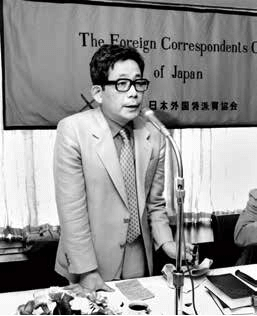
(from this month’s FCCJ Photo Archives Exhibition)
VIEW FROM THE TOP: HISTORY AND HORROR
CHIEF AMONGST THE CHERISHED features we will surely miss of the old Denki Building is the impressive view Members have enjoyed from its 20th floor. For years we’ve been privy to scenes of the evolution of the capital, thanks to the panorama stretching from the Imperial Palace to Tokyo Bay.
At no time did the pleasures of its panorama clash so dramatically with the horrific drama of breaking news as in the moment when Tohoku was hit by the giant earthquake on March 11, 2011. To most of us on the 20th floor that afternoon, the epicenter felt like it was under Tokyo. The building’s structural defense against earthquakes was its ability to sway widely, so damages from falling glassware, bottles of wine flying out of cabinets, and chairs tumbling over with their guests still in them, were disproportionate to the quake’s actual strength.
Moments later, we watched thick, black smoke rise from the garbage disposal island of Yumenoshima, then a large explosion in the direction of Chiba, which was reported later on the news screens as one of Idemitsu’s refineries. As members made our way from the Bar to the Media Room, then the Pen and Quill and Masukomi for a quick 360-degree assessment, we were pleasantly surprised to see little evidence of damage nearby. Taxis and buses were still making their way down the main traffic arteries, before the throngs of people began to flood onto the streets, stopping all transportation.
Perhaps the biggest surprise may have been the sight of members who climbed 20 flights to the Club in search of food and FCCJ’s antiquated land lines which heroically delivered where most cell phone connections failed. That night, the bar was packed with earthquake refugees telling tales of their trials trying to reach family and friends.
By the next morning, a wave of international reporters were arriving at the Club, as Japan took center stage for news. Unfortunately, the true scope of the earthquake/tsunami/ nuclear accident’s impact on the lives of millions in the region continues to evade us.
– Mary Corbett
Member since 1994
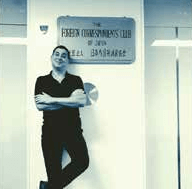
“The Foreign Correspondents’ Club of Japan is moving after decades. It feels like my parents sold the family home and moved to Florida”
Jake Adelstein, twitter, Oct. 26, 2018
Member since 2008
TWO FISTS AND A PLACE TO USE THEM
WHEN I ARRIVED IN Tokyo in 1977 the FCCJ, newly housed in the Denki Building, retained some of the Wild West atmosphere that had characterized the Club from the Occupation through the Korean War and Vietnam War years. Although bedrooms were no longer available upstairs for dalliances, the small Shimbun Alley bar spoke to the sexism of old by featuring our large, framed print of a nude Marilyn Monroe.
Two fistedness was the rule in more ways than one. One obstreperous member (now deceased) seemed to think the small bar was his personal domain. He got in the habit of drunkenly swinging at other members, failing to connect, falling to the floor and injuring himself.
The most memorable Denki Building fight occurred when a former Regular Member (also now deceased), who had left to study in the Caribbean at a for profit, low standards institution that we all denigrated as the “Papa Doc School of Medicine,” returned midway through his course for a visit and was drinking at a crowded correspondents’ table.
Taking issue with something said by a correspondent seated opposite him, the returnee snapped, “You’re crazy!” “Is that your medical opinion, Doctor?” came the reply, dripping with sarcasm. Enraged, the Papa Doc student leapt across the table, knocked his interlocutor to the floor and pounded his face until another Member separated the pair.
Things have calmed down considerably since those days.
– Bradley K. Martin
Member since 1978
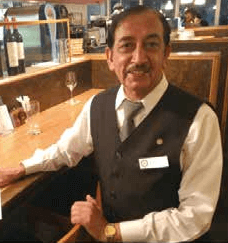
“Last call at the Foreign Correspondents’ Club of Japan @fccjapan, which shuts its doors today to move to a new building. Hanif has worked there for 37 years! お疲れ様”
Tokyotronic (Tim Hornyak), twitter, Oct. 26, 2018 Member since 2014

